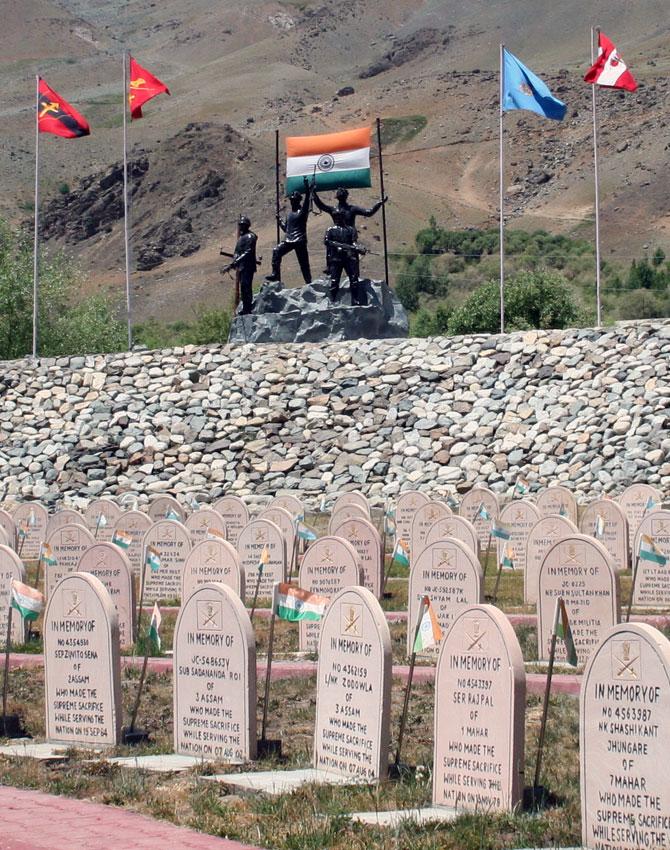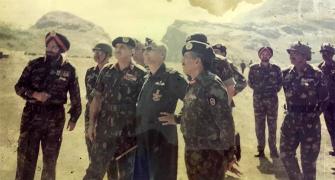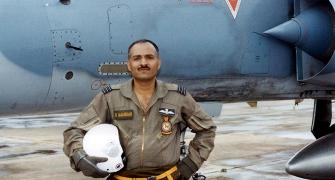'There is a sense of achievement but it has come at a great cost.'

Barely four months into his service, a young Lieutenant Balwan Singh led the Indian Army's Ghatak Platoon in a strategic assault on Pakistani intruders during the Kargil war and was among the brave soldiers who captured the Tiger Hill on July 4, 1999.
"There was no looking back from there. It was victory after the capture of the Tiger Hill," recalls Singh, now a colonel with the famed 18 Grenadiers, who was injured while fighting the enemy but continued to fight.
He was honoured with Maha Vir Chakra for his valour.
Raised in 1976, the 18 Grenadiers played a pivotal role in the war.
The battalion was conferred with 52 honours, including a Param Vir Chakra, two Maha Vir Chakra, six Vir Chakra, several Sena Medal and Commendation Card of the Chief of the Army Staff.
Colonel Singh and many other Kargil heroes from the battalion recalled the heroics of its bravehearts in Operation Vijay.
The war was declared over on July 26, 1999 after the Indian forces successfully pushed back the Pakistani forces which had stealthily occupied important heights in Ladakh.
On the night of July 3, 1999, soldiers of 18 Grenadiers, also called the Pole Star Battalion, embarked on their mission to capture the Tiger Hill and had accomplished the task by the next morning, said Brigadier (retd) Khushal Thakur, who commanded the battalion during the crucial battles of Tololing and Tiger Hill.
"On June 12-13, 1999, we won Tololing and it was a big turning point in this war. It boosted the morale of our armed forces and the countrymen and dipped the morale of the Pakistani side. One by one, we kept capturing the peaks in Mushkow or Batalik sector and the next task was Tiger Hill," Brigadier Thakur, who was a colonel during the war, told PTI.
"For the Tiger Hill, I had adequate time for reconnaissance. I had artillery guns, multi-barrel rocket launchers and high-altitude warfare equipment... Despite all the losses suffered, the morale of the men of 18 Grenadiers was sky high and our brave men captured the Tiger Hill, planting the Indian flag on top," he said.
There weren't many television channels back then but the defining images of Indian soldiers celebrating the conquest of the Tiger Hill became a symbol of their bravery.
Colonel Singh said the battles of Tololing and Tiger Hill were decisive battles.
"Initially, we captured Tololing. Tololing is very near to NH-1 Alpha (National Highway-1A). It is just 3 km of NH-1 Alpha. The same is the case with Tiger Hill, 8-10 km stretch of NH-1 Alpha is visible from top of the Tiger Hill. You can't do any movement on this road," he said.
"They (infiltrators) were having all kinds of weapons, automatics, anti-aircraft guns and other missiles on Tololing and Tiger Hill and both the features were very, very important to capture," Colonel Singh added.

The Indian Army will mark 25 years of the Kargil victory on July 26.
Many programmes have been held in the run-up to the main commemorative event in Kargil later this month.
Colonel Sachin Annarao Nimbalkar, who was about 23 years old and serving with the 18 Grenadiers as a captain during the conflict, was among the soldiers honoured with a Sena Medal for their bravery during the war.
"We were fighting with our backs to the wall and every inch that we had to capture was a big fight. The victory in the Kargil War was attained with great sacrifices made by various units.
"If I talk about my unit, 18 Grenadiers, we are bravehearts, two officers, two JCOs, and 30 other ranks sacrificed their lives and many others were injured and some disabled for life," Colonel Nimbalkar told PTI after paying homage to fallen heroes at the National War Memorial.
"So, this tells the cost of capturing the features of Tololing and Tiger Hill as far as my battalion was concerned," he said.
The army officer, who hails from Maharashtra, proudly shows the regimental insignia bearing the motto Sarvada Shaktishali emblazoned on his military cap and explains its origin.
"We are now celebrating the 25th year of Kargil Vijay Diwas... I remember when we were successful, I remember when we were facing casualties, I remember Lieutenant Colonel Viswanathan, who sacrificed his life during the battle of Tololing," he said.

Colonel Nimbalkar paid homage to his Indian Military Academy coursemate Capt Manoj Pandey and hero of the Tiger Hill battle on his death anniversary at the memorial.
"There are mixed emotions. There is a sense of achievement but it has come at a great cost," Colonel Nimbalkar said.
"Today is the day for all of us to collectively acknowledge the efforts of our heroes and sacrifices (they) made for the nation."
Feature Presentation: Aslam Hunani/Rediff.com







